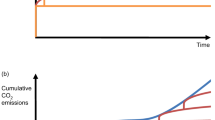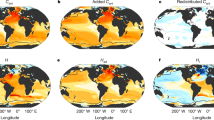Abstract
Climate model experiments reveal that transient global warming is nearly proportional to cumulative carbon emissions on multi-decadal to centennial timescales1,2,3,4,5. However, it is not quantitatively understood how this near-linear dependence between warming and cumulative carbon emissions arises in transient climate simulations6,7. Here, we present a theoretically derived equation of the dependence of global warming on cumulative carbon emissions over time. For an atmosphere–ocean system, our analysis identifies a surface warming response to cumulative carbon emissions of 1.5 ± 0.7 K for every 1,000 Pg of carbon emitted. This surface warming response is reduced by typically 10–20% by the end of the century and beyond. The climate response remains nearly constant on multi-decadal to centennial timescales as a result of partially opposing effects of oceanic uptake of heat and carbon8. The resulting warming then becomes proportional to cumulative carbon emissions after many centuries, as noted earlier9. When we incorporate estimates of terrestrial carbon uptake10, the surface warming response is reduced to 1.1 ± 0.5 K for every 1,000 Pg of carbon emitted, but this modification is unlikely to significantly affect how the climate response changes over time. We suggest that our theoretical framework may be used to diagnose the global warming response in climate models and mechanistically understand the differences between their projections.
This is a preview of subscription content, access via your institution
Access options
Subscribe to this journal
Receive 12 print issues and online access
$259.00 per year
only $21.58 per issue
Buy this article
- Purchase on Springer Link
- Instant access to full article PDF
Prices may be subject to local taxes which are calculated during checkout




Similar content being viewed by others
References
Matthews, H. D., Gillet, N. P., Stott, P. A. & Zickfield, K. The proportionality of global warming to cumulative carbon emissions. Nature 459, 829–832 (2009).
Allen, M. R. et al. Warming caused by cumulative carbon emissions towards the trillionth tonne. Nature 458, 1163–1166 (2009).
Zickfield, K., Eby, M., Matthews, H. D. & Weaver, A. J. Setting cumulative emissions targets to reduce the risk of dangerous climate change. Proc. Natl Acad. Sci. USA 106, 16129–16134 (2009).
Zickfield, K. et al. Long-term climate change commitment and reversibility: An EMIC intercomparison. J. Clim. 26, 5782–5809 (2013).
Gillet, N. P., Arora, V. K., Matthews, D. & Allen, M. R. Constraining the ratio of global warming to cumulative CO2 emissions using CMIP5 simulations. J. Clim. 26, 6844–6858 (2013).
IPCC, Climate Change 2013: The Physical Science Basis (eds Stocker, T. F.et al.) (Cambridge Univ. Press, 2013).
Collins, M. et al. in Climate Change 2013: The Physical Science Basis (eds Stocker, T. F.et al.) Ch. 12 (IPCC, Cambridge Univ. Press, 2013).
Solomon, S., Plattner, G-K., Knutti, R. & Friedlingstein, P. Irreversible climate change due to carbon dioxide emissions. Proc. Natl Acad. Sci. USA 106, 1704–1709 (2009).
Williams, R. G., Goodwin, P., Ridgwell, A. & Woodworth, P. L. How warming and steric sea level rise relate to cumulative carbon emissions. Geophys. Res. Lett. 39, L19715 (2012).
Friedlingstein, P. et al. Climate-carbon cycle feedback analysis: Result from the C4MIP model intercomparison. J. Clim. 19, 3337–3353 (2006).
Winton, M., Takahashi, K. & Held, I. Importance of ocean heat uptake efficacy to transient climate change. J. Clim. 23, 2333–2344 (2010).
Knutti, R. & Hergerl, G. C. The equilibrium sensitivity of the Earth’s temperature to radiation changes. Nature Geosci. 1, 735–743 (2008).
Church, J. A. et al. Revisiting the Earth’s sea-level and energy budgets from 1961 to 2008. Geophys. Res. Lett. 38, L18601 (2011).
Myhre, G., Highwood, E. J., Shine, K. P. & Stordal, F. New estimates of radiative forcing due to well mixed greenhouse gases. Geophys. Res. Lett. 25, 2715–2718 (1998).
Pierrehumbert, R. T. Short-lived climate pollution. Annu. Rev. Earth Planet. Sci. 42, 341–379 (2014).
Ciais, P. et al. in Climate Change 2013: The Physical Science Basis (eds Stocker, T. F.et al.) Ch. 6 (IPCC, Cambridge Univ. Press, 2013).
Le Quéré, C. et al. Trends in the sources and sinks of carbon dioxide. Nature Geosci. 2, 831–836 (2009).
Goodwin, P., Williams, R. G., Follows, M. J. & Dutkiewicz, S. Ocean-atmosphere partitioning of anthropogenic carbon dioxide on centennial timescales. Glob. Biogeochem. Cycles 21, GB1014 (2007).
Goodwin, P., Williams, R. G., Ridgwell, A. & Follows, M. J. Climate sensitivity to the carbon cycle modulated by past and future changes to ocean chemistry. Nature Geosci. 2, 145–150 (2009).
Zickfield, K., Arora, V. K. & Gillett, N. P. Is the climate response to CO2 emissions path dependent? Geophys. Res. Lett. 39, L05703 (2012).
Bindoff, N. L. et al. in Climate Change 2013: The Physical Science Basis (eds Stocker, T. F.et al.) Ch. 10 (IPCC, Cambridge Univ. Press, 2013).
Ridgwell, A. et al. Marine geochemical data assimilation in an efficient Earth System Model of global biogeochemical cycling. Biogeosciences 4, 87–104 (2007).
IPCC, Report on Emissions Scenarios (eds Nakicenovic, N. & Swart, R.) (Cambridge Univ. Press, 2000).
Krasting, J. P., Dunne, J. P., Shevliakova, E. & Stouffer, R. J. Trajectory sensitivity of the transient climate response to cumulative carbon emissions. Geophys. Res. Lett. 41, 2520–2527 (2014).
Sabine, C. L. et al. The oceanic sink for anthropogenic CO2 . Science 305, 367–371 (2004).
Li, C., von Storch, J-S. & Marotzke, J. Deep-ocean heat uptake and equilibrium climate response. Clim. Dynam. 40, 1071–1086 (2013).
Frölicher, T. L., Winton, M. & Sarmiento, J. L. Continued global warming after CO2 emissions stoppage. Nature Clim. Change 4, 40–44 (2014).
Winton, W., Griffies, S. M., Samuels, B. L., Sarmiento, J. L. & Frölicher, T. L. Connecting changing ocean circulation with changing climate. J. Clim. 26, 2268–2278 (2013).
Goodwin, P. & Lenton, T. M. Quantifying the feedback between ocean heating and CO2 solubility as an equivalent carbon emission. Geophys. Res. Lett. 36, L15609 (2009).
Archer, D. et al. Atmospheric lifetime of fossil-fuel carbon dioxide. Annu. Rev. Earth Planet. Sci. 37, 117–134 (2009).
Acknowledgements
This research was supported by UK NERC Postdoctoral Fellowship NE/I020725/2 and NERC grants NE/K012789/1 and NE/H017453/1.
Author information
Authors and Affiliations
Contributions
P.G. and R.G.W. provided the theory, with P.G. deriving the equations for the transient adjustment. A.R. conducted the supporting numerical modelling with GENIE. P.G. and R.G.W. led the writing of this study, and contributed equally, and A.R. provided comments on the manuscript.
Corresponding authors
Ethics declarations
Competing interests
The authors declare no competing financial interests.
Supplementary information
Supplementary Information
Supplementary Information (PDF 571 kb)
Rights and permissions
About this article
Cite this article
Goodwin, P., Williams, R. & Ridgwell, A. Sensitivity of climate to cumulative carbon emissions due to compensation of ocean heat and carbon uptake. Nature Geosci 8, 29–34 (2015). https://doi.org/10.1038/ngeo2304
Received:
Accepted:
Published:
Issue Date:
DOI: https://doi.org/10.1038/ngeo2304
This article is cited by
-
Warming proportional to cumulative carbon emissions not explained by heat and carbon sharing mixing processes
Nature Communications (2023)
-
Assessing the remaining carbon budget through the lens of policy-driven acidification and temperature targets
Climatic Change (2023)
-
Estimating the timing of geophysical commitment to 1.5 and 2.0 °C of global warming
Nature Climate Change (2022)
-
An important tool against combat climate change: Land suitability assessment for canola (a case study: Çanakkale, NW Turkey)
Environment, Development and Sustainability (2022)
-
An integrated approach to quantifying uncertainties in the remaining carbon budget
Communications Earth & Environment (2021)



